ProPublica came out this week with the best write-up so far of the full extent to which the FDA has been fighting to prevent us from having access to Covid-19 testing. Post is highly recommended.
We could have had lots of rapid tests early in the pandemic. Instead, many tests are still awaiting approval (aka they remain illegal) and we are facing massive shortages as people go around panicked trying to find a test.
Maddening non-sensical shifting standards and requirements are the FDA’s primary weapon, but simple inaction and delay are potent as well.
There’s a reminder of how the FDA did a similar thing with HIV testing and genetic testing, supposedly because of what might happen if someone got a positive test ‘without counseling.’
In the 1980s, the FDA banned home tests for HIV on the grounds that people who tested positive might do harm to themselves if they did not receive simultaneous counseling. In the 2010s, the agency cracked down on home genetic testing kits, concerned that people might make rash medical decisions as a result.
As opposed to what would happen if they didn’t get a positive test at all. I’m long past the point where I could consider this a well-intentioned mistake. There Is a War.
This is the conclusion, noting that missing a bar by 1% in FDA-land is also known as ‘missing a bar’ and ‘not better than having no test at all’:
And since rejecting Bosch’s submissions, the FDA has been coming around to her way of thinking. In March, the agency published a template for tests that would be used serially and sold in packages of two or more, allowing the kind of frequent testing she had advocated for. And last month, it published a new template that lowered the sensitivity standard for single-use over-the-counter tests to 80%.
Bosch had tests a year and a half ago that missed that bar by 1%.
For a while, even with the FDA’s attempts to stop it, as long as you were willing to pay about $10/test it was easy to get at-home Covid tests. Now that there’s need of them, that’s no longer the case. Stores across the city are sold out. Some places online still have tests, but Binex tests (which are the good ones) are extremely difficult to get, mostly sold out even at premium prices.


As a Buzzfeed report, note the contrast with how actual people talk:

Since our younger son’s last Covid test day at school, we went through an entire cycle of people getting low-level sick, doing rapid tests, and recovering, over the course of five days, before the tests from the school mostly came back. All were negative. There are similar reports from several other people I know.
It’s not only in America, things are completely out of hand.


We are also wasting a massive number of tests on children, who are required to get periodic tests ‘so they can keep going to school.’ They could go to school anyway, by… going to school. Or instead, we could double down on this waste of a limited resource, and focus what tests we have on school districts, as we are now doing in New York. I do appreciate the goal of not shutting things down on a single positive test, and if supply was abundant I’d be all for it, but it very much isn’t at this point and it’s only going to get worse for a while.
As always, make sure you know how to interpret your at-home test results.
Lines at Covid test tents keep getting longer here in New York, with most having dozens. The tests and their trucks do great work, but that doesn’t explain why we closed the testing sites at the airports. The return on testing capacity was always outstanding.
In San Francisco it seems things are also not so good (old news article about the closings).

Why don’t we have more rapid tests? The biggest problem continues to be lack of approval for the tests, also known as the FDA making many sources of rapid tests illegal, using standards that make no sense. Here’s the metaphor version.
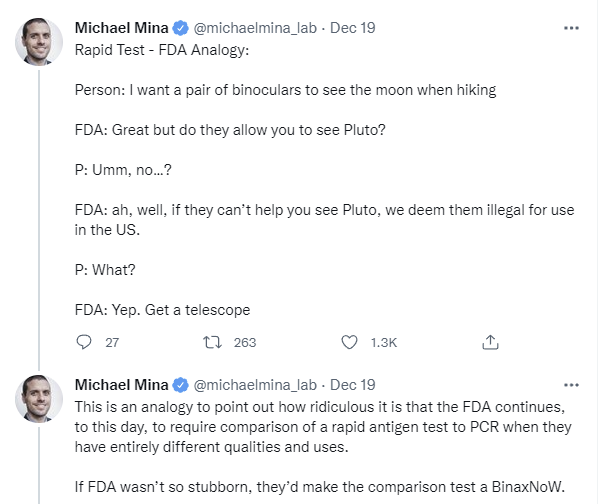
We could have hundreds of millions of additional tests, almost right away, including tests already used in Europe, if we simply made those tests legal. Here’s the more explicit version.
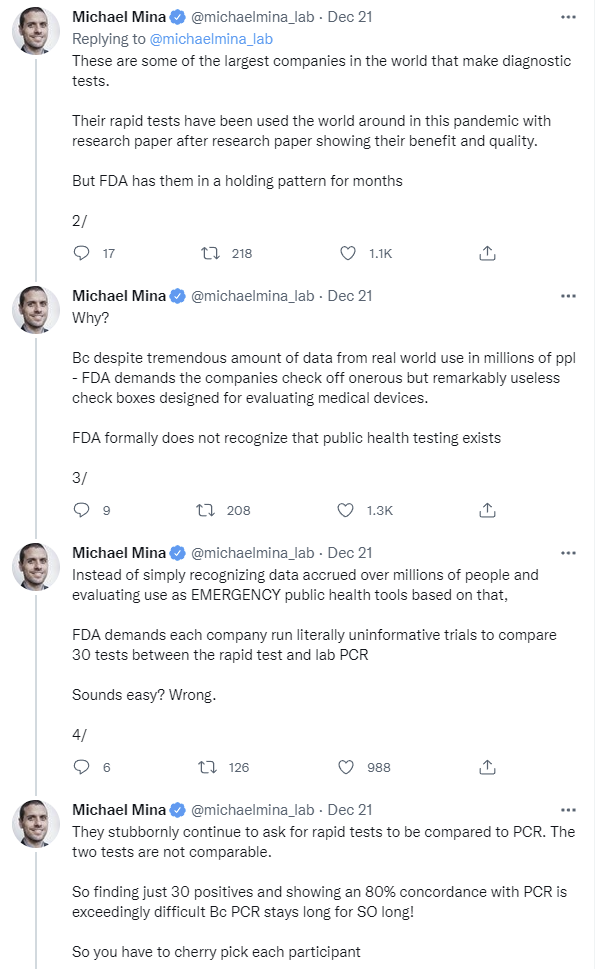
What is Biden going to do about this? No, he’s not going to put pressure on the FDA, let alone overrule them. That’s crazy talk.
He’s going to buy tests, that’s what he’s going to do, and send them to us. You know, send everyone in America a Covid test, no one’s press secretary would mock that excellent idea.
Alas, professionals talk logistics, and as has been the pattern for the Biden administration, actions are designed as symbols, and the logistics are a problem.



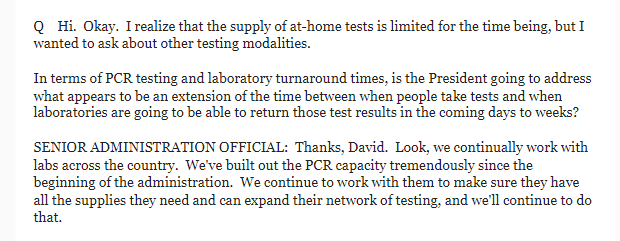
‘The supplies they need’ is not ‘the incentives they need’ nor is it ‘the regulatory permissions they need.’ Supplies are the kind of thing where Capitalism Solves This, if you fix the incentives and permissions. That’s not how these people think, and it shows.
Meanwhile, when testing is overloaded it slows down, because we’re unwilling to prioritize, which means all the tests become useless. You can’t know when to isolate, and you can’t get early interventions.


Making more Covid-19 tests legal would be a much more effective, and also much less expensive, way to get a bunch more tests. Instead, the tests Biden buys are coming out of our existing supply so they won’t arrive for a while, likely slower than they would have been given out anyway, and we won’t have more supply except on timescales of expanding manufacturing capacity. Except that with the Omicron wave likely over in a few months, and no advance commitments, who is even going to bother expanding capacity?
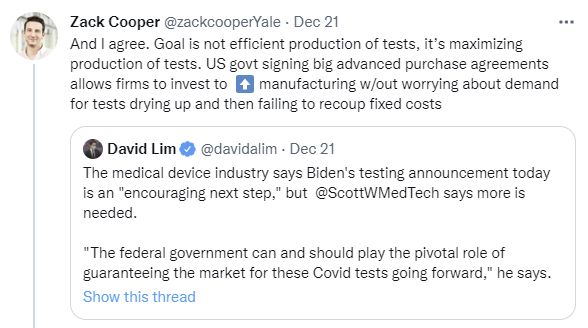
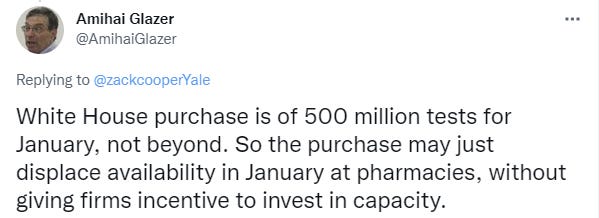
We also continue to not give robust guidance on how to use testing, and there’s every reason to believe a lot of testing over the holidays will be on the first day after exposure when tests won’t detect it yet. Even if Omicron’s generation time is down to two or three days, this window will still exist. With abundant tests this wouldn’t be a big deal, because we’d simply test again.
But if tests are hard to find, the supply must be rationed and one’s reserve conserved. Who is going to be able to test multiple times without symptoms? We wouldn’t even want them to do that right now. What should you do if your supply is limited, and you also don’t want to burn through too much of our collective supply, but you do want to stay safe and keep others safe?
Even more than everything else I write, not medical advice. But it looks like maximizing efficiency is about to be a lot more important. The biggest thing is to not test on the first day after a potential exposure. That’s a waste, a negative means little. Wait at least two days, and unless you have symptoms I’m guessing it’s better to wait until day three (isolating on day two to the extent you can) if you only get one test. And if you’re protected and aren’t going to expose anyone vulnerable, and you can’t easily restock tests or don’t want to hog them, maybe save your powder for when you have symptoms.
And remember why you had to do that.
FDA Delenda Est. But FDA not unique. We have it bad but so do many others. MR cites the example of Canada.

Somewhat OT but time-critical questions from the El Dorado of nanogold-antibody conjugates:
How sensitive are NHS rapid tests (Xiamen Biotime, April ’21 vintage) vs omicron? What does it mean if a close contact gets a positive PCR but negative rapid test? (on the same day that I was last in contact with them)
Of course I’ll continue to do a rapid test every day as per guidelines but I’m not sure whether to postpone visiting elderly relatives.
Not seeking medical but practical advice: We’re a family of 4 in Germany, so we have 4..8 at-home tests available per week (2 mandatory per kid + 2..4 we buy whenever we feel the need). If one of us were positive, we’d all isolate. so using one test per person seems insanely inefficient. Are there good reasons not to add several swaps to one test? Doing one test per day or adding a swap for us in one of the kids tests seems way more efficient (but of course it’s not the officially approved way).
I don’t know if it would still reliably work under home conditions, but if they would, that makes logical sense.
Uh so I’m pretty sure you can buy a test for like 2$ in any supermarket in Germany, why skimp on tests?
Not that I see the value in testing more frequently than your mandatory school tests unless you’re meeting relatives or something, but will you really feel as safe if you’re not sure you’re doing everything 100% correctly? At least that’s how I’d feel, and unless rapid tests in Germany have run out I don’t see the benefit.
When you say BinaxNow are the “good ones,” do you mean in terms of ease of use or do you think they’re more accurate?
They’re much easier to use. Accuracy is similar as far as I can tell.
Really? I found BinaxNow confusing and unintuitive compared to IntelliSwab or QuickVue. (I wrote more about this here. :) ) The only advantage I saw to it was that, like, there’s no tube of liquid that someone could accidentally knock over.
(Of course, now with any tests being so scarce, you can’t really pick your particular preference anymore!)
Pingback: Get Set, Also Go | Don't Worry About the Vase
Me: Zvi’s posts are great, I hope he continues to provide actionable info.
*Monkey’s paw finger curls*
This is a disturbingly precient post for me personally. My kid’s piano teacher got a text right after their lessons on Wednesday that a bunch of people at the teacher’s gym got covid. She’s asymptomatic but took a test and came back possitive.
I’m sitting on a moderate sized pile of Binax tests and trying to figure out when to administer them. My kids and wife have roles in church service Friday and Saturday, and we are trying to figure out when to administer tests. We live in a major metro where we can’t find any at any price. Given this, assuming no symptoms, I’m open to any and all suggestios from people about when to test.
If you can do one test per person you do it Friday morning, as close to services time as possible.
Anecdote from the holidays about the difficulty of deciding how to use testing:
Big, difficult-to-arrange extended family gathering (~20 adults) with agreement that everyone would rapid test on the day of. Christmas morning rolls around and a crucial participant tests positive. We give her another rapid test from a different brand. Negative. A third rapid test from the same box as the first. Positive. We scramble and fortunately find a PCR site that can get us same-day service. Negative. Apparently the original box was one of the ~1% of lots that produces a false positive. But we burned through most of our spare rapid tests and most of Christmas Day figuring that out.
Arguably we got unusually unlucky with the false positive, but in the aggregate something like this was pretty likely to happen and it’s difficult to know how to follow up on a positive rapid test.
Pingback: Covid 12/30: Infinity War | Don't Worry About the Vase